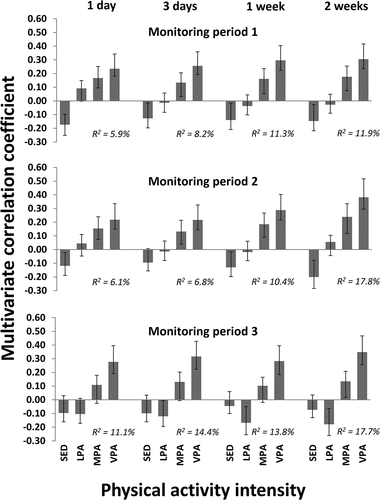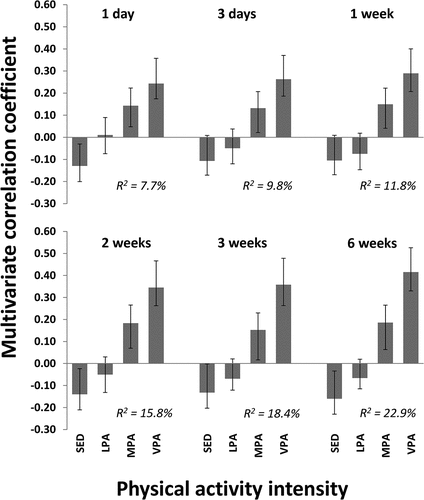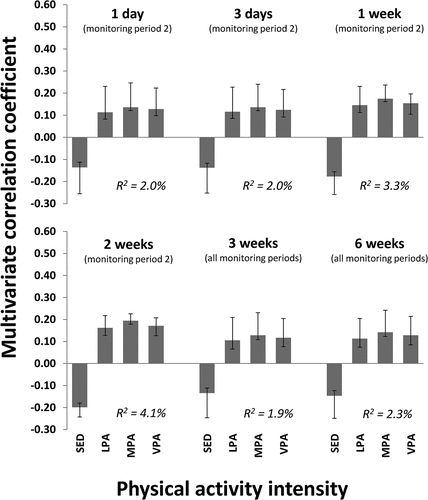Figures & data
Table 1. Children’s characteristics at each timepoint. Numbers are mean (SD) or %.
Table 2. Mean (SD) levels of physical activity and sedentary time for the different descriptors.
Figure 1. Cross-sectional associations between physical activity and lower body muscle strength for each monitoring period using descriptors derived using different monitoring length. Results are reported as multivariate correlation coefficients from a joint model including the 4 physical activity intensity variables adjusted for sex, age, body mass index and wear time. Multivariate correlation coefficients can be interpreted equivalent to bivariate correlations, although they are derived from the multivariate model. Physical activity assessments were conducted for 14 consecutive days during September – October (monitoring period 1), January – February (monitoring period 2) and April – May (monitoring period 3). SED = sedentary time; LPA = light physical activity, MPA = moderate physical activity, VPA = vigorous physical activity. R2 = explained variance.

Figure 2. Cross-sectional associations between physical activity and lower body muscle strength across monitoring periods using descriptors derived using different monitoring length. Results are reported as multivariate correlation coefficients from a joint model including the 4 physical activity intensity variables adjusted for sex, age, body mass index and wear time. Multivariate correlation coefficients can be interpreted equivalent to bivariate correlations, although they are derived from the multivariate model. Results for data from 1 day to 2 weeks of monitoring are the means of estimates from each monitoring period modelled separately, while data on 3 and 6 weeks of monitoring are estimates for means across the first and both weeks of monitoring across all monitoring periods, respectively. SED = sedentary time; LPA = light physical activity, MPA = moderate physical activity, VPA = vigorous physical activity. R2 = explained variance.

Figure 3. Prospective associations between physical activity and lower body muscle strength for descriptors derived using different monitoring length. Results are reported as multivariate correlation coefficients from a joint model including the 4 physical activity intensity variables adjusted for sex, age, body mass index and wear time. Multivariate correlation coefficients can be interpreted equivalent to bivariate correlations, though they are derived from the multivariate model. Results for data from 1 day to 2 weeks of monitoring are estimates from monitoring period 2 (which was the only monitoring period where we found a significant model), while data on 3 and 6 weeks of monitoring are estimates for means across the first and both weeks of monitoring across all monitoring periods, respectively. SED = sedentary time; LPA = light physical activity, MPA = moderate physical activity, VPA = vigorous physical activity. R2 = explained variance.

Data availability statement
The datasets used for the current study are available from the corresponding author on reasonable request.
